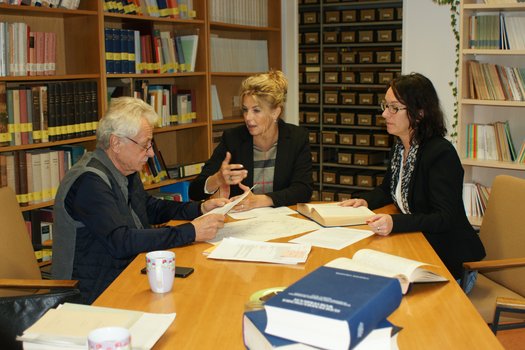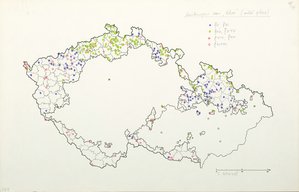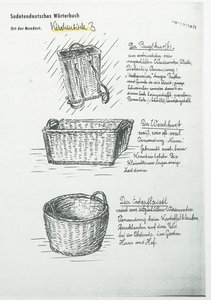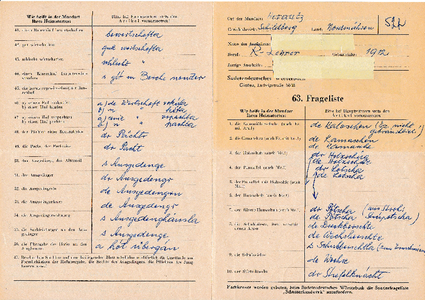Gießen: The Sudeten German Dictionary
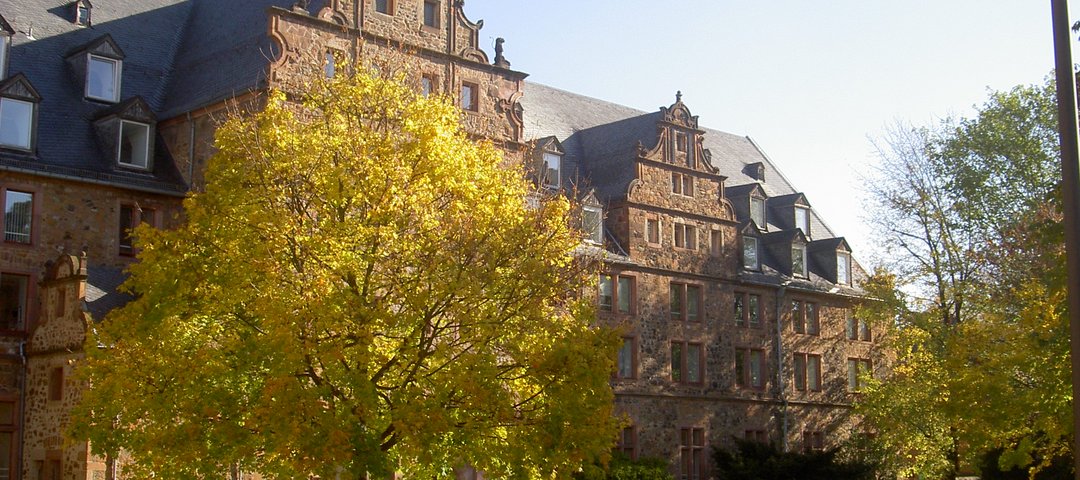
The Sudetendeutsche Wörterbuch. Wörterbuch der deutschen Mundarten in Böhmen und Mähren-Schlesien (Sudeten German Dictionary. Dictionary of German dialects in Bohemia and Moravia-Silesia – SdWb) is a dialectal dictionary documenting the dialects spoken by the “Sudeten Germans,” by which is meant those German-speaking peoples who, before they fled or were driven out of the then Czechoslovakia (or – during German occupation the “Protectorate of Bohemia and Moravia"), lived in Bohemia (Čechy) or Moravia-Silesia (also known as “Czech Silesia” – “země Moravskoslezská”). The dictionary’s editorial team is based at Justus-Liebig-Universität Giessen, which is one of Collegium Carolinum’s working locations.
Major Dialect Landscapes
Dialects spoken by the Sudeten Germans in the former Czechoslovakia are marked by a strong influence from Eastern Central and Upper German and can be divided on a macro scale into five major dialectical spaces:
- Middle Bavarian, spoken in southern Moravia, in the lower and middle Bohemian Forest region, in Hrěbečsko (Schönhengstgau) (the largest enclave of German speakers in the region) and in the German-speaking enclaves of České Budějovice (Böhmisch Budweis), Vyškov (Wischau), Brno (Brünn), Olomouc (Olmütz) and Skřípov (Wachtl)
- North Bavarian or Upper Palatine German in western Bohemia and in the German-speaking enclave of Jihlava (Iglau)
- East Franconian in northwestern Bohemia, in Hrěbečsko and in north central Moravia
- Upper Saxon in northern Bohemia and mixed with Northern Bavarian in the German-speaking enclave of Jihlava.
- Silesian German in the eastern part of northern Bohemia, in eastern Bohemia and in northern Moravia.
Goals
The Sudeten German dialects are an important part of the history of the Czech and (pan-)German languages. Due to the political and social events that unfolded in the wake of the Second World War in Western and Central Europe, however, some Sudeten dialects are already extinct, and those that are not are in decline. The aim of the SdWb is therefore to document their uniqueness and distinctiveness in the words and idioms of the dialects for the benefit of Western and Central European linguistic, cultural and social history, in order to anchor them within the culture of memory in Europe.
The documentary nature of the indexing work also provides numerous starting points for further research. In addition to cultural-anthropological and historical studies of the Sudeten German dialects, the basic research undertaken for the SdWb dictionary offers opportunities in linguistic research – particularly in research studying the dynamics of language change in the light of dialectal and foreign-language hybridization, taking into account the specific circumstances of the various regions affected by such processes (including political influences, phenomena emerging out of contacts with others, etc.)
History of the Dictionary
An example of a completed original questionnaire from the SdWb’s main catalog.
Research work on the dialects of Bohemia and Moravia began as early as around the middle of the 19th century, but systematic work to establish a Sudeten German dictionary of dialects was not to commence in the Czechoslovak Republic until 1930, at the suggestion of Leipzig Germanist Theodor Frings. Frings was busy at the time with the preparatory work for a dictionary of the then Free State of Saxony and requested his colleagues Erich Gierach and Ernst Schwarz, who both worked at the Charles University in Prague, to compile a collection of the dialects spoken in those parts of western and northern Bohemia that bordered Saxony. Over the following few years, Schwarz and Gierach († 1943) created a resource bundle of 15 questionnaires, 1,200,000 voucher slips and about 800 distribution maps, all of which was largely in place by the end of the war in 1945, but was then lost in period that followed. For the two researchers, as for the German population of the Sudetenland, the creation of this first monument to the region’s German dialects in the 1930s and early 1940s, a labor undertaken out of a deep love for the heimat, was also a work of identity reinforcement and a politically loaded enterprise, especially so in the light of both figures’ – but especially Gierach's – closeness to nationalist ideology and later to National Socialism.
The beginnings in the early years of the Federal Republic of Germany of what has today become the SdWb was an initiative that allowed an effort to secure and preserve a Sudeten German identity shine through beyond the political implications formerly associated with that identity. Franz Joseph Beranek, who had begun his academic career at the German Charles University and had been appointed to the professorship of the Folklore and Tribal History of Moravia in Prague in 1944, along with Ernst Schwarz, who had accepted a call to the Friedrich-Alexander University of Erlangen-Nuremberg, commenced work on building up a new collection. After his expulsion from Czechoslovakia, Beranek had migrated to Hesse, first settling in Butzbach and then in Giessen. Together with his wife Hertha Wolf-Beranek, who was instrumental in setting up the project for the new dictionary at his side, he began assembling the materials for the new collection, initially in his private home, until he was allocated rooms at Justus Liebig University in Giessen in 1959. The SdWb “officially” came into existence on 1 May 1957. Ernst Schwarz exercised the role of chairman of the dictionary commission and head of the registry / editorial office until 1978. He was succeeded by Heinz Engels as chief editor, while Beranek became head of the registry / editorial office. He was succeeded by his wife Hertha after his death in 1967, with Horst Kühnel becoming co-director of the enterprise in 1974. After the latter’s retirement, all duties – i.e. the responsibility for publishing the dictionary – were transferred to Heinz Engels. He in turn was succeeded by Otfrid Ehrismann upon his retirement in 1994.
Work on the collection was effectively complete by the end of 1980. A secure home for the collection was guaranteed by the University of Giessen, while financial support was provided by the State of Hesse, the German Research Foundation and, from 1986 on, the Free State of Bavaria. The SdWb became affiliated to the Collegium Carolinum e. V. as one of its working locations.
The current working material of the SdWb consists of 16,500 field maps and 2.6 million voucher slips. In addition to this, ongoing work has considerably increased the number of the 182,000 synonym references initially collected. The material was compiled from about 72,500 questionnaires, each containing an average of about 60 questions, which were supplemented by special lists taking in particular professional groups and specialist topics, heimat chronicles, books, journals and research publications, as well as word collections and voluntary submissions. The handwritten material was transcribed by research assistants and archived alphabetically and archived alphabetically under High German lemmata (using Duden). Since then, staff members trained in German language studies have created the individual word articles. In 1988 Heinz Engels finally succeeded in publishing the first issue of the SdWb.
The publications of the Collegium Carolinum provide regular information about the work on the dictionary. Up until 201,1 this information was provided in the form of separate Reports on the SdWb, and from that time on it was included in the Annual Reports of Collegium Carolinum. The plan is to produce the dictionary over 10 to 12 volumes and to issue approximately 80 pages at yearly intervals.
Structure of Articles in the Dictionary
While the dictionary articles in the SdWb follow precise guidelines, these guidelines have changed over the course of the dictionary's history. You can find an overview on this topic here.
Volume I up to and including Volume V
1. Lemma:
- The approach taken to ordering the main as well as any possible secondary lemmata is based on the 1976 - 1981 edition of Duden and is thus largely standardized.
- If any word in the archive is not listed there, its new High German form is determined using Jacob and Wilhelm Grimm’s German Dictionary, other dialectal dictionaries and/or through the application of phonetic rules.
- Diminutives are treated under the lemma for their full nominal form, though if the relevant noun has not already got an entry, the diminutive receives its own lemma.
- The same applies to nominalizations, which usually appear in the entry for the verb or adjective from which they are derived.
- Auxiliary references are generated for a standardized keyword if the affected dialect expression is outdated in the standard, but exists in its new form in both Duden and the dictionary archive. Particularly frequently used independently created short and diminutive forms of first names are recorded in an auxiliary note and thereafter dealt with under their original names.
2. Grammatical entries:
- The organization of the grammatical entries: in the SdWb are largely governed by the corresponding definitions in the grammar section of Duden.
- The categorization of verbs in terms of their valency (i.e. whether such verbs are transitive or intransitive, reflexive and/or impersonal), work that continued to be carried out until the 5th delivery for Volume V, is no longer done from the lemma herunterrollen onwards.
3. Phonetic descriptions:
- The guidelines of the “Teuthonista” (a journal of dialect research) provide the basis of phonetic transcriptions.
- In all volumes up to and including Volume V, the simplexes documented in the collection are provided with a detailed phonetic description.
- Phonetic descriptions of verbs always include the infinitive, usually accompanied by the following inflection forms for strong and irregular verbs: “1st pers. sing. pres.”, “3rd pers. sing. pres.”, “1st pers. sing. imp.” and Part. II”
- In the case of adjectives, their comparatives and superlatives are also given a phonetic description wherever they are documented in the archive.
- In exceptional cases, composites or derivatives are also given a phonetic head; this is the case, for example, if the pronunciation of a complex word’s individual components has clearly distanced itself from the basic word.
4. Semantic system:
- If several meanings are assigned to a word, all such meanings are listed starting from the primary meanings down through the word’s derived meanings. If a keyword also designates plants, the corresponding entries are listed at the end of the relevant article.
- For economic reasons, the dictionary makes cross-references wherever possible instead of detailed term definitions. This approach proves particularly useful when dealing with synonyms and heteronyms, since in such cases it is always possible to make a reference specific central synonym, under which the detailed definition of meanings, as well as a listing of all lemmata with the same meaning is given.
- It is essential to document selected sample sentences, phrases, idioms, farming and weather proverbs from the dialectal heritage as evidence of the use of a word in practice. Such dialectal samples are assigned to the relevant keyword meaning in the semantic section of that article.
Information on geographical distribution: The abbreviations used in distribution information are chosen on the basis of “Orientierungskarte 2 – Kleinräumige Gebietsbezeichnungen” (“Orientation Map 2 - Small-scale area designations") in Volume I. Terms, meanings and examples are considered to be widespread (“verbr.” – “verbreitet”) in a particular area if there are six or more records of their use that area; they are occasionally included (marked with an “*”) in cases where there are three to six such records. In cases of single isolated records of their use, exact location abbreviations are given. In cases of single isolated records taken from literary sources, the precise abbreviation of the area or location alluded to in the source is given, followed by the abbreviation for the relevant literary reference. The location and literary abbreviations used for this purpose were last updated and published in a preliminary list of locations and literature in 2008.
II. Modifications from Volume VI onwards
Mainly as a result of streamlining measures adopted in 2018, the following changes have since been made to the structure of articles, starting in Volume VI:
To 2. Grammatical entries:
- If a noun is included in the SdWb's archives without any reference to its genus, instead of the previous practices of including an indication “o. Art.” (which stands for “ohne Artikel” – ‘without article’), the degree symbol is used (“°” – indicating that the entry was received by the dictionary with 0 information on its genus).
To 3. Phonetic descriptions:
- While no detailed description of the phonetics of a term are considered necessary anymore, the dictionary continues to list what are referred to as ‘besondere Lautungen’ (bes. Ltg(n). – “exceptional pronunciations” – see below on the introduction of a separate section for footnotes). Such listings are used, for example, where a phoneme occurs that makes it difficult to identify a word as a result any of a number of phonetic phenomena (assimilations, contractions, etc.).
To 4. Semantic system:
- With the aim of enabling the reader to get a comprehensive impression of the variety of phonemes and of the syntactic use of words after the removal of ‘traditional’ phonetic descriptions, the dictionary includes as many sample dialectal sentences and phrases examples as possible. This gives the reader a presentation of the dialects documented in the dictionary in close step with actual linguistic practice.
One structurally radical modification made to the dictionary is the addition of a separate section for remarks under each dictionary article. This change is what made it possible to dispense with detailed phonetic descriptions. In addition to the above-mentioned exceptional pronunciations, other types of valuable notes may also be placed in this section wherever it is deemed necessary or helpful (on etymology, for example). This may help prevent misunderstandings and can provide helpful pointers for further research activities.
Editorial Staff and Contact Details
The editorial staff of the Sudetendeutsches Wörterbuch is based in Giessen. It is made up of Isabelle Hardt and Bettina Hofmann-Käs under the management of Prof. Thomas Gloning.
Contact Details
